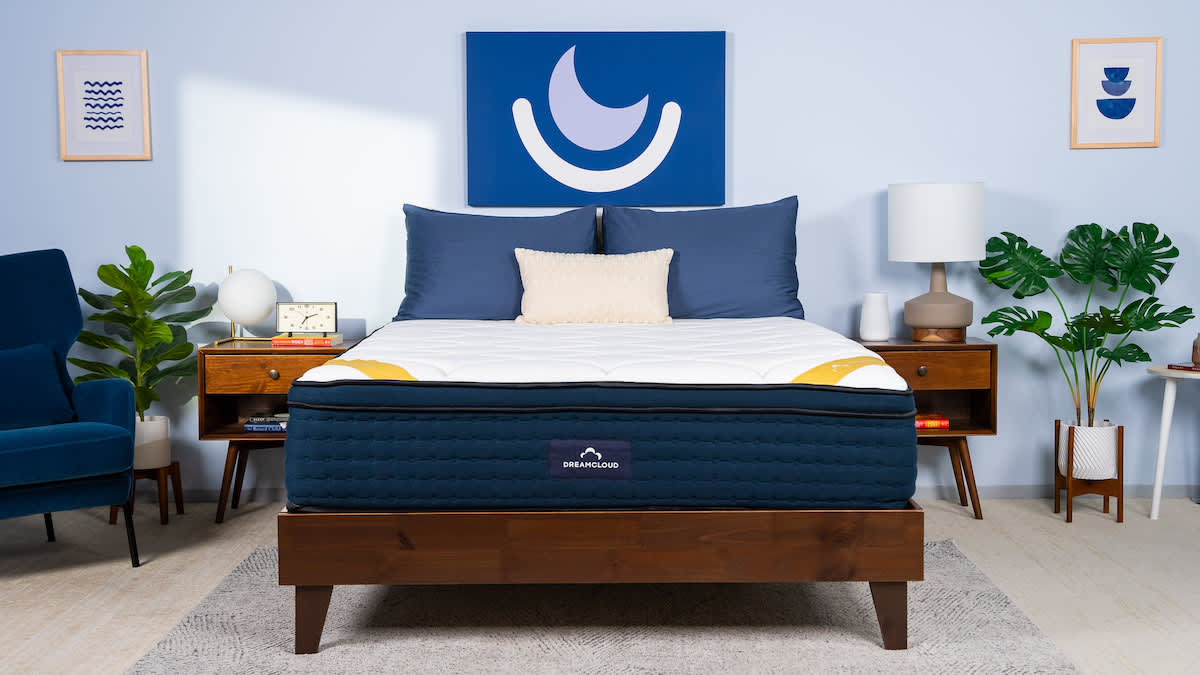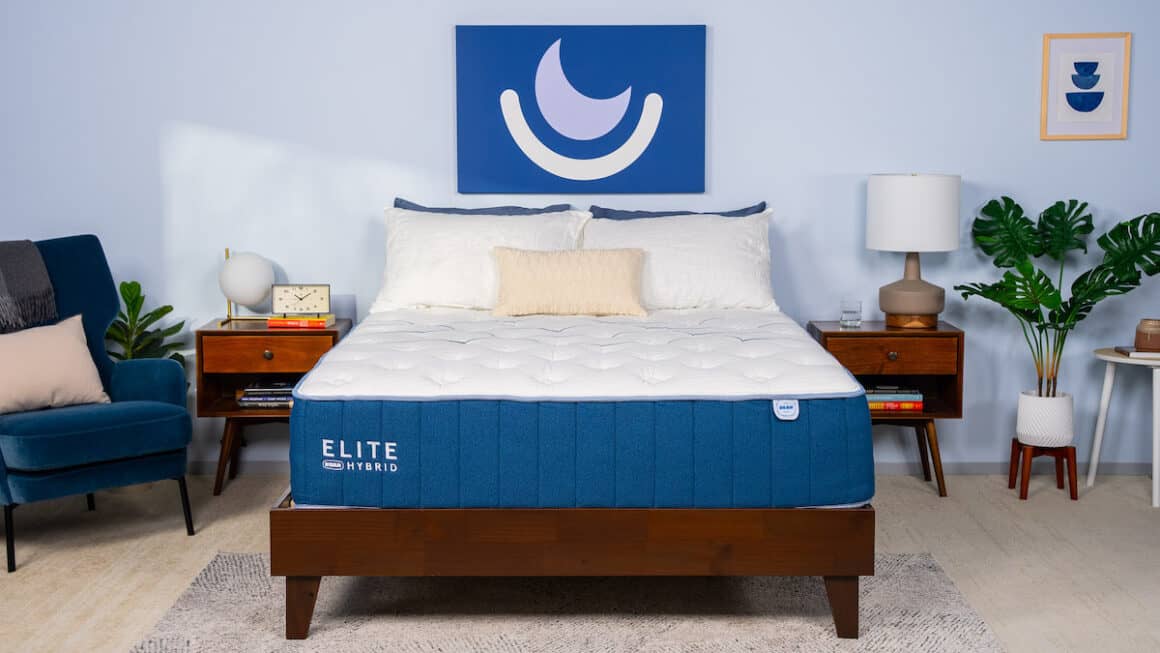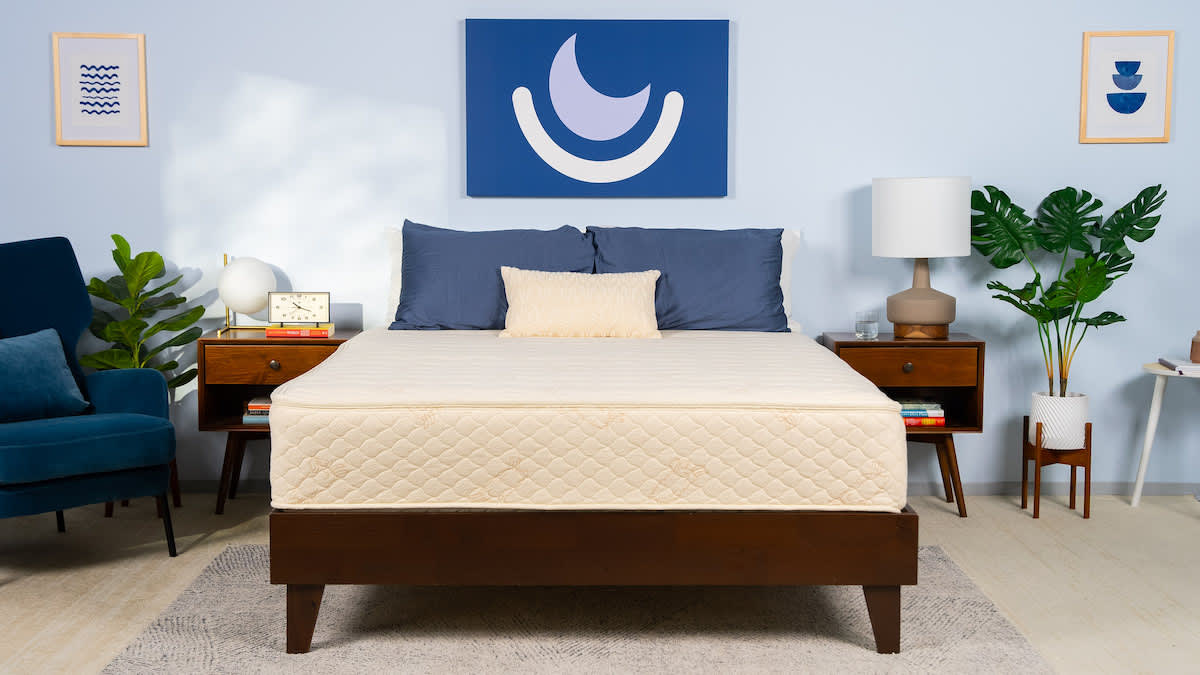On This Page
Best Mattress for Back Pain in 2025 (Doctor Recommended)
Our Top Picks
-
Best Overall Mattress
WinkBeds EcoCloud -
Best Value Mattress
Brooklyn Bedding CopperFlex Memory Foam -
Most Comfortable Mattress
DreamCloud Premier Memory Foam -
Best Luxury Mattress
Saatva Rx -
Best Mattress for Side Sleepers
Bear Elite Hybrid -
Best Mattress for Spinal Alignment
Nolah Evolution 15 -
Best Extra Firm Mattress
Plank Firm -
Best Mattress for Pressure Relief
FloBeds vZone 12" Natural Latex Mattress
Best Overall Mattress
WinkBeds’ EcoCloud delivers a balanced latex hybrid design that cushions the body with zoned support and alleviates sore spots along the spine. Other highlights include excellent temperature control, a sturdy perimeter, and easy movement across the surface — all at a reasonable price-point.
Pros & Cons
Pros
- Latex comfort system provides softer cushioning for the hips and shoulders, with firmer support for the lower back and midsection
- Zoned pocketed coils in the support core aid spinal alignment
- Firmer coils around the bed’s perimeter enhance edge support
Cons
- May be too soft for sleepers over 230 pounds
- Sleep partners may feel each other’s movements on the other side of the bed
Ratings
Our Take
Best Value Mattress

The Brooklyn Bedding CopperFlex Memory Foam Mattress offers dependable back support at an affordable price. Its medium firm (6) feel, cushioning memory foam layers, and sturdy base give it a comfortable and balanced feel that’s great for most side and back sleepers.
Pros & Cons
Pros
- Targeted lumbar support for people with back pain
- Excellent motion isolation
- Affordable price-point
Cons
- Foam layers can give off an initial “new mattress smell”
- $99 fee for return shipping
Ratings
Our Take
Most Comfortable Mattress

The DreamCloud Premier Memory Foam Mattress offers excellent contouring, with a medium firm (6) feel that makes it a touch firmer than some of the other all-foam beds we’ve tested. It’s a good fit for people who need the best of both worlds when it comes to cushioning and sturdiness.
Pros & Cons
Pros
- Strong motion isolation is ideal for couples
- 365-night sleep trial
Cons
- Foam is prone to heat retention
- Some sleepers may notice slight off-gassing smell at first
Ratings
Our Take
Best Luxury Mattress

The Saatva Rx is one of the only mainstream mattresses specifically designed for people with chronic or frequent back pain. Plush foam layers cradle your body to alleviate aches and soreness in the lumbar region, while sturdy coils create a stable base layer without making the mattress feel overly stiff.
Pros & Cons
Pros
- Dense lumbar pad alleviates pain and pressure in the lower back
- Foam-tipped coils minimize motion transfer to prevent sleep disturbances for couples
- All orders include a 365-night trial and free White Glove delivery
Cons
- Most back and stomach sleepers will find the mattress too soft
- Sticker price is much more expensive than average
Ratings
Our Take
Best Mattress for Side Sleepers

The Bear Elite Hybrid combines adaptive memory foam with multi-zone support layers, making it a solid choice for side sleepers who need extra cushioning for their shoulders and hips without too much hug. Three firmness levels allow you to choose the best option based on your body type.
Pros & Cons
Pros
- Zoned support layers push back against heavier areas of the body
- Three firmness options to accommodate different types of sleepers
- Cooling materials help the surface maintain a comfortable temperature
Cons
- Strong off-gassing for the first few nights
- Limited options for people seeking an exceptionally soft mattress
Ratings
Our Take
Best Mattress for Spinal Alignment

The high-profile Nolah Evolution 15 is built with thick foam layers over multi-zone coils, ensuring a comfy balance of cushioning, support, and pushback for your entire body. Three firmness options allow you to further tailor the mattress to your body type, sleep position, and personal preferences.
Pros & Cons
Pros
- Thick foam layers conform to the body without sinking too deeply
- Zoned coils provide extra bounce and reinforcement around the midsection
- Available in three firmness levels to accommodate different sleeper types
Cons
- Returns incur a $99 fee
- Thick profile requires a fitted sheet with deep elastic pockets
Ratings
Our Take
Best Extra Firm Mattress

Brooklyn Bedding’s Plank Firm is a flippable all-foam mattress with firm (7) and extra firm (9) sides. Both surfaces provide excellent support, especially for people who weigh more than 230 pounds and tend to sink too much on softer foam mattresses.
Pros & Cons
Pros
- Exceptionally firm and supportive on each side
- Provides sturdy pushback for back and stomach sleepers over 230 pounds
- Both sides sleep quite cool
Cons
- Neither side is soft enough for most side sleepers and people under 130 pounds
- Subpar motion isolation due to the highly responsive surface
Ratings
Our Take
Best Mattress for Pressure Relief

The FloBeds vZone 12” Natural Latex Mattress stands apart from other latex mattresses with an option to pick different firmness levels for each half of the bed. It’s a great solution for co-sleepers with different firmness preferences.
Pros & Cons
Pros
- Choice of four firmness options allows people with back pain to choose their best fit
- Customizable design lets shoppers pick a separate firmness for each side of the bed
Cons
- Choice of four firmness options allows people with back pain to choose their best fit
- Customizable design lets shoppers pick a separate firmness for each side of the bed
Ratings
Our Take
Compare Our Top Picks
| Mattress | Mattress Type | Ideal For | Value | Sleep Trial |
| WinkBeds EcoCloud | Hybrid | Hot Sleepers | Good Value | 120 nights (30-night requirement) |
| Brooklyn Bedding CopperFlex Memory Foam | Foam | Side and Back Sleepers | Great Value | 120 nights (30-night requirement) |
| DreamCloud Premier Memory Foam | Foam | Couples | Great Value | 365 nights (30-night requirement) |
| Saatva Rx | Hybrid | Lightweight Side Sleepers | Fair Value | 365 Nights ($99 Return Fee) |
| Bear Elite Hybrid | Hybrid | People With Back Pain | Good Value | 120 nights (30-night break-in period) |
| Nolah Evolution 15 | Hybrid | Most Sleepers | Good Value | 120 nights (30-night requirement) |
| Plank Firm | Foam | Hot Sleepers | Great Value | 120 nights (30-night requirement) |
| FloBeds vZone 12" Natural Latex Mattress | Latex | Couples | Great Value | 100 nights |
Dr. Breus On Choosing a Mattress For Back Pain
What Should Someone With Back Pain Consider in a Mattress?
For people with back pain, the ideal mattress keeps the spine in even alignment from the head to the pelvis. To find the right mattress, consider your body type and sleeping position, as well as several performance factors that affect a mattress’ ability to ease pain.
Sleeping Position, Body Weight, and Mattress Firmness
Your sleeping position significantly influences the mattress features necessary to promote spinal alignment. Side sleepers typically need a softer surface that lets the shoulder and hip areas sink into the bed’s surface, while back and stomach sleepers usually benefit from firmer support to prevent arching in the lower back.
At the same time, body weight plays a major role in determining suitable mattress firmness. People under 130 pounds often prefer a softer mattress, those over 230 pounds typically benefit from firmer beds, and sleepers in between those weight ranges often find comfort in a mattress with a mid-range feel.
Mattress Material
A mattress’ construction and materials affect its ability to relieve pressure and ease pain. Common mattress types include foam, innerspring, hybrid, latex, and airbed.
- Foam: Contours to the body; good for pressure relief
- Innerspring: Old-school responsiveness with a thin comfort layer
- Latex: Gently responsive and lightly contouring; often favored by back and stomach sleepers
- Hybrid: Balances contouring with support; versatile for all positions
- Airbed: Adjustable firmness for tailored back support
For back pain, we often recommend mattresses that strike a balance between contouring and support, such as one of the best hybrid mattresses featuring zoned support.
Zoned Support
Zoned support refers to mattresses that are constructed to provide varied firmness levels to different parts of the body. This feature can offer major benefits to sleepers with back pain, as it provides enhanced support to heavier areas like the midsection while allowing lighter areas to sink into the bed’s surface. Together, these zones can promote better spinal alignment and reduce stress on the back.
Pressure Relief
Pressure relief in mattresses involves the cushioning of pressure-prone areas to prevent discomfort and pain, particularly in the hips, shoulders, and lower back. Typically essential for those with back pain, effective pressure relief ensures a more comfortable sleep by minimizing stress on sensitive areas and promoting proper spinal alignment.
Is Your Mattress Making Your Back Pain Worse?
Your mattress may be causing or exacerbating back pain if it lacks the features needed to support your body weight and sleeping position. We’ve identified several signs that your mattress may be contributing to back pain:
- You frequently wake up with back pain: If your back pain starts when you get out of bed or gets worse in the morning, it may be a signal that your mattress is to blame.
- You no longer feel comfortable on your mattress: Another common sign of an unsupportive mattress is if you find yourself tossing and turning at night and have trouble finding a comfortable and pain-free position.
- Your mattress has reached the end of its lifespan: If your mattress is over 7 to 10 years old, it may have reached the end of its lifespan. Old mattresses often sag in the middle and no longer support healthy spinal alignment.
How to Prevent Back Pain While Sleeping
Finding relief from nighttime back pain can take some experimenting, so you may want to start by creating a back-friendly evening routine. Make time for relaxation, spend up to 15 minutes before bedtime with a heating pad on low, and bring several extra pillows or rolled up blankets into bed for targeted support.
Try Sleeping in a Different Position
Finding a comfortable sleeping position can help reduce strain on the back. Experts often recommend sleeping on your back with a pillow under your knees or in the fetal position with a pillow between your knees. Avoid stomach sleeping if possible, which can increase pressure on the spine and may lead to back strain.
Boost Your Mattress’ Feel with a Topper
A mattress topper is a quick and easy way to change the feel of your bed. Depending on your needs, you can opt for a topper that adds cushioning to relieve pressure points or one that increases firmness for better spinal alignment.
Use a Pillow that Aligns Your Neck and Spine
Selecting the best pillow for back pain with the right loft can help maintain alignment between your neck and spine, thus improving sleep posture and potentially reducing pain. Side sleepers generally benefit from a thicker pillow, back sleepers often prefer a medium loft, and stomach sleepers usually need a pillow with minimal loft to avoid straining the neck and arching the spine.
Consider Speaking With Your Doctor
If back pain persists or consistently disrupts your sleep, consult a health care professional. They can offer personalized advice and treatment options tailored to the cause of your back pain.
Discover More Mattress Solutions
In addition to this curated guide to the best mattresses for back pain, our product testers selected beds that we think will help alleviate other issues that can interfere with quality sleep.
More Mattress Options for Specific Needs
How We Test
At the heart of our recommendations is a thorough, real-world testing methodology that we use to assess each mattress we review. We’ve honed our expertise over many years in the sleep product industry, learning everything we can along the way to help you find a mattress that feels comfortable and promotes healthy spinal alignment.
In testing mattresses for people with back pain, we paid close attention to factors like each bed’s construction and how well it balances support and pressure relief. Members of our testing team, who span a range of body types and sleep styles, helped us narrow down our picks to those that are best suited to different types of sleepers with back pain. We also consider what customers have chosen as the best-selling mattresses for back pain to confirm what works in the lab works at home.
Frequently Asked Questions
Back pain can disrupt sleep by making it difficult to find the right position, fall asleep, and sleep consistently through the night. For people with chronic back pain, trouble sleeping can make back pain worse, leading to a cycle where poor sleep exacerbates pain, which in turn further disrupts sleep.
Your mattress may be causing back pain if you toss and turn and can’t find a comfortable position, if you consistently wake up with soreness, or if your mattress is past its expected lifespan of 7 to 10 years.
The ideal mattress firmness for back pain depends on your sleeping position and body weight. In general, the less a person weighs, the more likely they are to benefit from a soft mattress, with firmness preferences increasing as body weight increases.
At the same time, side sleepers are more likely to receive the pressure relief they need from softer beds, while back sleepers typically require firmer pushback to keep the back and spine on an even plane. Stomach sleepers usually trend toward the firm end of the spectrum, since beds that are too soft can result in uncomfortable arching of the spine.
The best mattress type varies based on your individual needs and preferences. While several mattress types offer a good mix of cushioning and support, we’ve found that hybrids are often the best for back pain, as they combine the supportive properties of coils with the pressure relief of foam or latex layers.
The best sleeping position for back pain is typically on your back or side, as both allow for proper spinal alignment in the right circumstances. Try sleeping on your back with a blanket rolled up under your knees or sleeping on your side with a pillow between your knees. Stomach sleeping is generally not recommended as it can trigger or exacerbate back pain.
